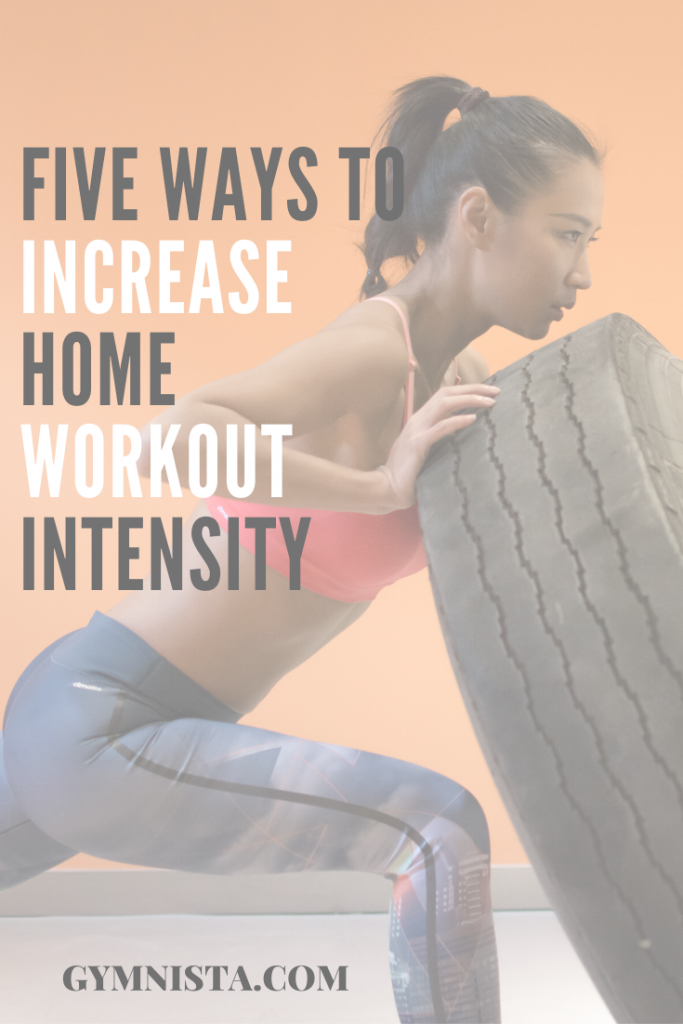Even with a small home gym, a home workout doesn’t have to fall short in intensity. Keeping workouts fresh with major and minor tweaks help to ensure results and prevent boredom.
Gyms have reopened in some areas. If you’re like me, you don’t want to feel like the sacrificial lamb going back to the gym. Or, you’re not comfortable being in an enclosed space without a mask. Whatever the reason, I wanted to share a few ways to keep the intensity up with your workouts.
These are all things you can do on your own without the help of a trainer. Let’s keep the calorie burn going and the motivation up while staying safe at home.

Perform Circuits
Circuit training is moving from one exercise to the other with minimal rest. Most gyms are set up so that you can perform circuits easily. They group all the upper, and lower body equipment together for ease of use. Regardless of whether you’re circuit training or not, it’s easy to hop from one piece of equipment to another.
It’s easy to set your home gym up for circuits as well. Whether you workout in the garage, a dedicated space in your home, or the living room, you can get set up for circuits. The major key, is to plan the workout ahead of time.
By writing down all the exercises in order, along with sets and repetitions, you create a blueprint for circuit set up. With a blueprint in hand, it’s easy to see the flow of exercises, what equipment is needed and how to lay it out.
Label the circuit for ease. Set up the equipment; exercise bands, weighted bars, exercise ball etc., in order of exercises, then go.
Move from one exercise to the other with no more than 60-seconds of rest between exercises. Keep up with rest time by using a stopwatch. Once all the circuits are done, so are you.
Try High Intensity Interval Training
Most of the trendy, and tough workouts you see on television use this principle. High Intensity Interval Training or HIIT is alternating 20 seconds of work with 10 seconds of rest. The alternating pattern continues eight times, or for eight rounds. It amounts to roughly four minutes of exercise.
It’s call high intensity because the exercises involve maximal effort. Think alternating lunges, push ups, mountain climbers, or jumping jacks. For the most part, exercises utilize bodyweight instead of equipment.
When designing your own HIIT workout, pick one exercise for a session, or alternate two. Execute each exercise with proper form to minimize injury and to maximize effort. Use an interval timer to cue work and rest time. Using a timer keeps you honest as well.
I would personally limit HIIT training sessions to a maximum of twice each week. Also, not on consecutive days. More like a Monday, Friday or Tuesday, Friday schedule. One HIIT workout in the middle of the week is good also with other days of pure strength training.
Add Cardio Intervals
Throw a couple cardio intervals into a workout between resistance training exercises for more intensity. By cardio, I mean full body moves; burpees, jumping jacks, step ups, and mountain climbers.
Your feet don’t have to leave the ground if you don’t want them to either. Things like inchworms, slow mountain climbers, side hops, modified jumping jacks, and even lunges will work as cardio intervals also. Just get the heart rate up above resting levels for a few seconds in between resistance training moves.
Time the movements with a stopwatch if you want to train for time instead of repetitions.
Alternate Lower, then Upper Body
Right after performing a lower body exercise, perform an upper body exercise. Rest after the combo as much, or as little as you want. The large muscle contractions of the lower body have the ability to raise your heart rate alone. Follow a squat with a move like bent over rows and notice how your heart rate soars.
Alternating just those two, very basic, moves can shift a workout from “just getting in some movement,” to “dear God what was I thinking?!” Actually, it will just turn a workout into a sweat fest and then you’ll notice the calorie burn increase on your activity tracker.
This is the favorite for me personally, to take my workouts to the next level. Any combo of exercise is fine for this, think deadlift to bent over rows, or overhead press and front squat. Keep the favorites in rotation, so that there’s something to look forward to. Of course this is a full body workout so, allot time during the week for rest.
Shorten Rest Time between Exercises
Keep the rest time between exercises to a minimum. Having a stopwatch keeps me honest when keeping track of rest time. It keeps the workout moving, and helps prevent distraction also. I usually rest for 60 seconds between exercises. If I want to adjust the intensity, I rest for 45 seconds instead.
Start with small adjustments at first. It doesn’t seem like much, but from 60 to 50 seconds could potentially feel like a lifetime lost.
Stay honest, keep moving, burn calories is the name of the game. Switching things around weekly, keeps home workouts fresh and help with preventing plateaus. It’s also something to look forward to as things in quarantine can get a little mundane.
Hope this was helpful. Give me a shout if it sparked some ideas.
0
